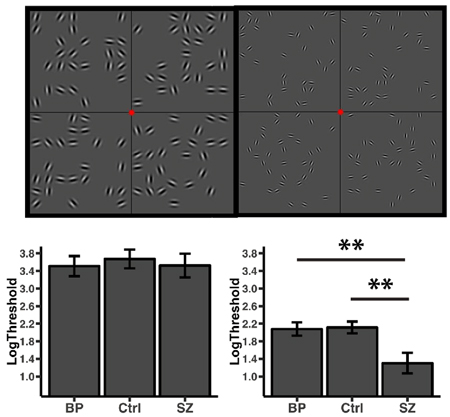Projects
Neural basis of size contrast “Ebbinghaus” illusions in health and psychosis
 Prior work has shown that the expanse of V1 cortical activation depends on the Ponzo “railroad” illusion, wherein objects that appear further away also appear larger (Murray et al., 2006). However, this has not yet been shown with the Ebbinghaus illusion in which the physical size of surrounding objects modulates the perceived size of a central target (see Figure); nor has it been linked to neuropsychiatric symptoms which are known to modulate such illusions (Silverstein et al., 2016). We have a behavioral and fMRI dataset that directly addresses these questions and we welcome any input from eager students or volunteers.
Prior work has shown that the expanse of V1 cortical activation depends on the Ponzo “railroad” illusion, wherein objects that appear further away also appear larger (Murray et al., 2006). However, this has not yet been shown with the Ebbinghaus illusion in which the physical size of surrounding objects modulates the perceived size of a central target (see Figure); nor has it been linked to neuropsychiatric symptoms which are known to modulate such illusions (Silverstein et al., 2016). We have a behavioral and fMRI dataset that directly addresses these questions and we welcome any input from eager students or volunteers.
Neural basis and stimulus conditions for contour integration deficits in psychosis
 In a contour integration paradigm, subjects identify the screen quadrant location thought to contain a circular target. Target detection is non-trivial because it is embedded within a field of randomly oriented “noise” elements. Contour integration is investigated because it is impaired in schizophrenia (Silverstein et al., 2000), arising by the first psychotic episode (Keane et al., 2016), and because it elicits abnormal activity in V2-V4, LOC, and frontal/parietal cortex (Silverstein et al., 2009). For an ongoing K01 award, I am conducting another fMRI contour integration study that will potentially replicate past results. This study will also allow a direct comparison with bipolar disorder, and bring new functional connectivity methods to bear on the issue. Therefore, this investigation has the potential to confirm and extend previous neuroimaging work on contour integration deficits in SZ. In addition to the neural data, we have a behavioral dataset that considers the stimulus attributes that contribute to impaired contour integration in SZ. In this data set, we are finding that relatively specific stimulus feature combinations (spatial frequency, Gaussian envelope, etc.) amplify integration deficits in schizophrenia patients relative to bipolar patients and healthy controls (see Figure).
In a contour integration paradigm, subjects identify the screen quadrant location thought to contain a circular target. Target detection is non-trivial because it is embedded within a field of randomly oriented “noise” elements. Contour integration is investigated because it is impaired in schizophrenia (Silverstein et al., 2000), arising by the first psychotic episode (Keane et al., 2016), and because it elicits abnormal activity in V2-V4, LOC, and frontal/parietal cortex (Silverstein et al., 2009). For an ongoing K01 award, I am conducting another fMRI contour integration study that will potentially replicate past results. This study will also allow a direct comparison with bipolar disorder, and bring new functional connectivity methods to bear on the issue. Therefore, this investigation has the potential to confirm and extend previous neuroimaging work on contour integration deficits in SZ. In addition to the neural data, we have a behavioral dataset that considers the stimulus attributes that contribute to impaired contour integration in SZ. In this data set, we are finding that relatively specific stimulus feature combinations (spatial frequency, Gaussian envelope, etc.) amplify integration deficits in schizophrenia patients relative to bipolar patients and healthy controls (see Figure).
